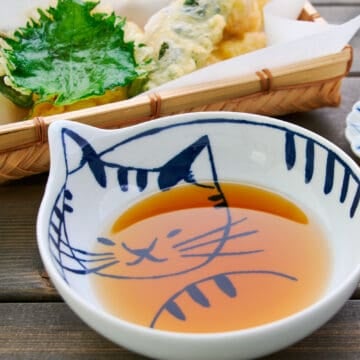Tempura is a sophisticated subgenre of Japanese cuisine, and the best tempura restaurants offer counter seating with prices comparable to their sushi counterparts. With fresh vegetables and seafood lightly encrusted in a crisp, lacey batter, it’s an elegant food that calls for a delicate sauce. In this recipe, we harness the umami power of dashi, blend it with the savory notes of soy sauce, and round it off with the subtle sweetness of sake and sugar. The result is a refined, concentrated dipping sauce that promises to elevate your tempura experience to the next level.
Why This Recipe Works?
Using a blend of soy sauce and salt to season the tempura sauce makes for a more refined tentsuyu that doesn’t overpower delicate tempura. A small amount of sugar balances out the sauce’s saltiness while enhancing the dashi’s umami. This Japanese tempura sauce recipe is on the concentrated side to account for dilution from condiments like ginger and daikon.
Ingredients for Tempura Dipping Sauce
Dashi - Dashi stock is the backbone of many dishes in Japanese cuisine, and tentsuyu is no different. I highly recommend making dashi from scratch using kombu (dried kelp) and katsuobushi (smoked, dried, and fermented, and shaved skipjack tuna, a.k.a. bonito flakes). This Japanese soup stock gives the broth a mildly smoky flavor and rich umami taste. You can substitute instant dashi powder with water (diluted according to the package directions). If you want to make this vegan, you can make a vegan dashi stock by soaking dried shiitake mushrooms and kombu in water overnight. Soy Sauce - Another fundamental ingredient in Japanese cooking, soy sauce adds salt and a deep savory note to the tempura sauce. It’s crucial for achieving that authentic tentsuyu taste; however, you don’t want to add too much, or its earthy flavor will overwhelm the other ingredients. For a gluten-free tempura sauce, tamari (soy sauce made from just soybeans) can be used. Sake - This Japanese rice wine contributes a subtle sweetness and additional umami to the tempura sauce. Cooking the tentsuyu boils off the alcohol, but you can skip it if you can’t find it. Also, if you have access to real brewed mirin (a sweet rice wine), you can substitute it for the sake and skip the sugar. Sugar - A touch of sugar smoothes over the sharpness of the salt, giving the dipping sauce a more sophisticated taste. It’s a small but significant addition highlighting the umami from the dashi and soy sauce. Salt - While soy sauce provides the necessary depth to the sauce, adding too much will make it dark brown, burying the subtle flavor of the dashi (not to mention the tempura itself). Using some salt to season the tentsuyu makes it possible to get the perfect balance of seasoning and refinement.
Condiments for Tentsuyu
Daikon - This giant white stalagmite-shaped radish is a common condiment to serve grated alongside tempura sauce. At tempura restaurants in Japan, you’ll often get a bowl of grated daikon or daikon oroshi, which can be added to the sauce and eaten as a palate cleanser. In tentsuyu, it adds a refreshing flavor while helping the thin sauce cling to whatever you dip in it. When choosing daikon, look for one that’s thick and firm with smooth white skin. Daikon is always sweeter towards the top (thick end) and spicer towards the bottom, so I recommend using the top part for grating. Ginger - Fresh ginger offers a zesty, pungent kick to the tentsuyu, complementing the subtler flavors and adding a refreshing note. It’s particularly good with seafood like shrimp tempura.
How to Make Tempura Sauce
Start by combining dashi, soy sauce, sake, sugar, and salt in a pot and bring to a boil over medium heat. This boiling is crucial—it intensifies the sauce’s flavors and ensures the evaporation of alcohol, which could otherwise impart an unwanted sharpness. Once it comes to a full boil, cook the sauce for one minute or until it no longer smells like alcohol. Grate the ginger using a fine grater such as a Microplane. I like to grate daikon a daikon grater which has large slits that prevent it from getting clogged, but you can also use the rasp side of a box grater. Because daikon contains so much water, it’s important to lightly drain it in a strainer for a few minutes to keep your tempura sauce from getting water when it’s added in. Tentsuyu should be served hot, with grated ginger and daikon on the side. It can be stored in an airtight container for up to a week and reheated.
How to Use Tempura Dipping Sauce
Aside from the obvious foods to dip in this sauce, like my mushroom and vegetable tempura, or savory shrimp tempura, this sauce can be used with a variety of other foods. Kakiage is a type of tempura where a mixture of shredded vegetables and sometimes seafood are bound together in a light batter to make a crisp fritter and it goes beautifully with this tentsuyu. In Oita prefecture on the island of Kyushu, Toriten, or Chicken Tempura, is a popular staple that goes well with this dipping sauce.
📖 Recipe







